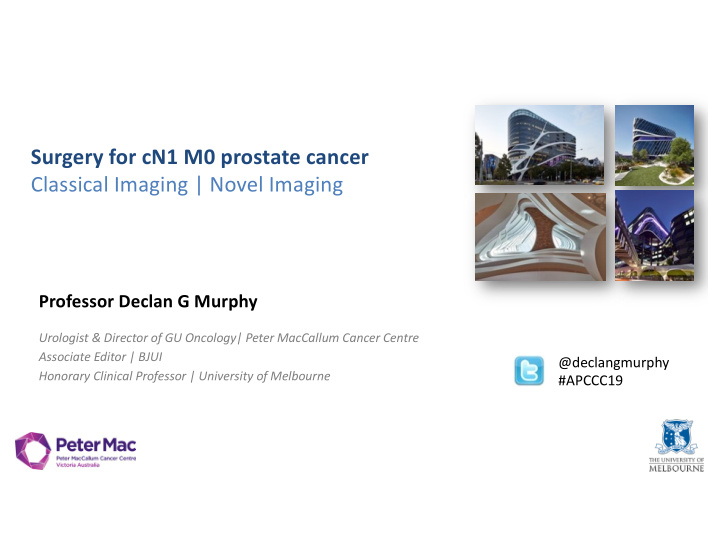



Surgery for cN1 M0 prostate cancer Classical Imaging | Novel Imaging Professor Declan G Murphy Urologist & Director of GU Oncology| Peter MacCallum Cancer Centre Associate Editor | BJUI @declangmurphy Honorary Clinical Professor | University of Melbourne #APCCC19
Disclosures • None relevant
Surgery for cN1 M0 prostate cancer | Outline 1. cN1 by conventional imaging 2. cN1 by PSMA PET/CT
Staging of high-risk localized/locally advanced disease EAU Prostate Cancer Guidelines 2019
Staging of high-risk localized/locally advanced disease Definition of pelvic cN1 by CT criteria 8mm short axis of a round lymph node 10mm in an oval lymph node CT performs very poorly for staging MRI performs poorly for staging pelvic lymph nodes pelvic lymph nodes Sensitivity 39-56% • Sensitivity 11-13% • Specificity 89-94% • Specificity 93-94% • EAU Prostate Cancer Guidelines 2019 Woo et al AJR 2018 Briganti et al Eur Urol 2012; Gabriele et al World J Urol 2016
Surgery for high-risk locally advanced prostate cancer EAU Prostate Cancer Guidelines 2019
Surgery for high-risk locally advanced prostate cancer 1 2 EAU Prostate Cancer Guidelines 2019
1 N=302 RP + ePLND |1988-2003 All were pN1 50 (17%) were cN1 | 252 (83%) were cN0 Median follow-up 17.4y cN0 and cN1 compared Cancer-Specific Mortality Hypothesis – no difference in survival cN0 = 23% cN1 = 26% Patient profile Mean PSA 32.2ng/mL 65% NCCN high risk Median node yield = 13 Moschini et al Eur Urol 2016
1 Predictors of CaP mortality MVA Gleason 8 and number of positive nodes predicted survival cN status did not predict survival Conclusion “cN+ status should not be a contraindication to surgery” Moschini et al Eur Urol 2016
2 Overall survival National Cancer Database 2003-2011 • LT +/- ADT • N=2967 cN1 • Local therapy (LT) +/- ADT vs ADT alone 67% received LT +/- ADT • 37.8% surgery • HR 0.31 32% received ADT o ADT alone 95% CI 0.13-0.74; p=0.007 62% radiotherapy • 71% survival benefit in favour of local therapy 85% received ADT o Instrumental variable analysis • Seisen et al Eur Urol 2018
Surgery vs Radiotherapy 2 Compared using instrumental variable analysis Seisen et al Eur Urol 2018
Surgery vs Radiotherapy 2 Compared using instrumental variable analysis RP +/- ADT RT +/- ADT HR 0.54 95% CI 0.19-1.52; p=0.2 OS benefit for surgery Not significant Seisen et al Eur Urol 2018
Take home messages 1 | Conventional imaging • Conventional imaging performs poorly for staging cN status • There is some low quality evidence to support surgery for cN1 prostate cancer • Must be discussed within a multimodal framework
Surgery for cN1 M0 prostate cancer | Outline 1. cN1 by conventional imaging 2. cN1 by PSMA PET/CT
Perera et al Eur Urol 2019
PSMA PET | Primary LN staging Sensitivity 0.77 (0.46-0.93) Specificity 0.97 Perera et al Eur Urol 2019
• Novel imaging is more sensitive • However, benefit of detecting metastases earlier is unclear • Not clear if PET-only metastases should be treated systemically, or aggressive local and metastasis-directed therapy • RCTs evaluating management impact awaited (proPSMA) EAU Prostate Cancer Guidelines 2019
• N=300 High-risk localized • Princess Alexandra Hospital prostate cancer Randomised squence • CT/Bone scan • • PSMA PET/CT Endpoints • Accuracy • Management impact • Hofman et al BJUI 2018
proPSMA | Prospective randomized study of PSMA PET/CT vs conventional imaging Trial Design Objectives Patient Selection: untreated, biopsy-proven prostate cancer, being Primary considered for curative intent treatment. PSA ≥ 20 ng/mL or Gleason Grade Group 3-5 or clinical stage≥T3 § •Accuracy Randomisation 1:1 PSMA PET/CT CT + bone scan Secondary Crossover to other arm unless ≥3 distant metastases •Management impact Implementation of Final Management •Health economics •Radiation exposure 6 months follow-up: repeat imaging •Reporter agreement •Safety Up to 54 months follow-up for PSMA negative patients Primary endpoint to be presented EAU 2020 Hofman et al BJUI 2018
1 proPSMA study 69yo | PSA 12.2 | cT2b right | PIRADS 5 right | Grade group 5 (targeted bx only; 6/6 cores)
46 year old; PSA 14; cT3; PIRADS 5; Grade group 5 cancer 2 proPSMA study | CT and bone scan normal
46 year old; PSA 14; cT3; PIRADS 5; Grade group 5 cancer 2 proPSMA study | CT and bone scan normal
46 year old; PSA 14; cT3; PIRADS 5; Grade group 5 cancer 2 proPSMA study | CT and bone scan normal
46 year old; PSA 14; cT3; PIRADS 5; Grade group 5 cancer 2 proPSMA study | CT and bone scan normal Proceed with primary rx alone? Best systemic therapy? Plus local therapy?
Considerations | Management impact If conventional imaging is negative, how • much should we abandon standard of care? – ie surgery or radiotherapy Should we try harder for tissue diagnosis? • (No) How should we assess the management • impact? Can prospective trials embrace novel • imaging? (yes please)
PSMA-GUIDED SURGERY Maurer et al., Eur Urol 2018
PSMA-radioguided surgery for LN detection • Injection of 110-150MBq 111 In-labeled PSMA- ligand 24h prior to surgery • Intraoperative detection by gamma probe with acoustic and visual feedback Maurer et al., Eur Urol 2018
PSMA-radioguided surgery for LN detection Maurer et al., Eur Urol 2018
Excellent correlation between RGS and histopathology 83.6% sensitivity 100% specificity Maurer et al., Eur Urol 2018
Take home messages 2 |Novel imaging • Self-evident that PSMA PET/CT has superior sensitivity and specificity in higher-risk prostate cancer – proPSMA will provide objective evidence • Disruptive technology • The management impact needs to be evaluated • Also offers radio-guided surgery possibility
Conclusions | Surgery for cN1 prostate cancer • Strong evidence for local therapy in cN1 MO prostate cancer (by conventional imaging) • Surgery is an option as part of multi-modal therapy • Novel imaging provides much more accurate picture of disease extent • Management impact needs to be evaluated • Surgery role likely better defined
Thank you w: petermac.org e: declan.murphy@petermac.org @declangmurphy #APCCC19
Recommend
More recommend